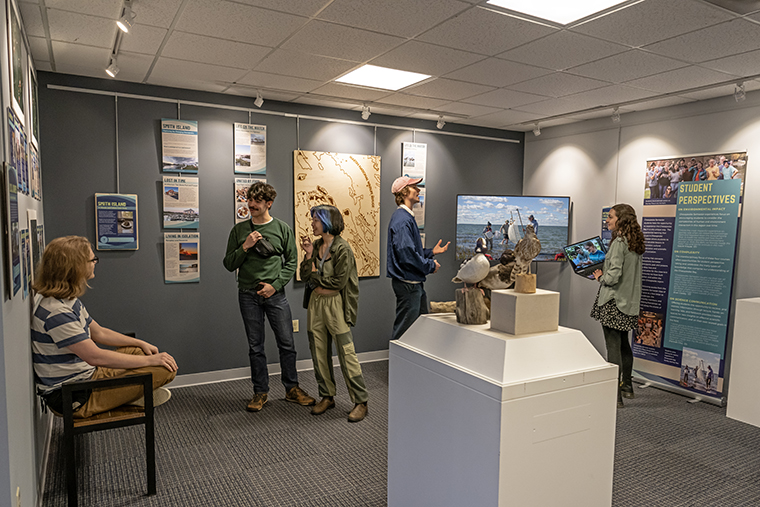College Opens MuSE: A Community Museum in Downtown Chestertown
The space will host rotating exhibitions curated by students, faculty and staff dedicated to work at the intersection of environment and community.

Students with work in the Chesapeake Semester exhibit talk in MuSE: A Community Museum
as installation is completed.
The Washington College Center for Environment and Society (CES) officially opens MuSE: A Community Museum, beginning at the March 1 First Friday.
The space, located in downtown Chestertown, will host rotating exhibits highlighting
Washington College teaching, experiential learning, and research with opportunities
for sharing, learning, and dialogue in a community space. Each exhibit will be informational,
interactive, and highly visual, creating a dynamic space for learning and sharing
for the Eastern Shore community.
“Facilitating shared knowledge and understanding to drive action for conservation and community resilience is at the core of our mission,” said CES Director Valerie Imbruce. “This new off-campus space will aid us in creating opportunities for active collaboration for both teaching and learning for our Washington College community, community organizations, regional K-12 educators, students, and interested visitors. We’re excited to welcome the community into this new, innovative, and collaborative space.”
The first exhibit in the new, updated, and enhanced space at 210 South Cross Street is “Teaching & Transformation: Semester in the Chesapeake Classroom.” It showcases the nature and culture of the Chesapeake Bay region through the final projects created by Washington College’s Chesapeake Semester students. Their hand-drawn maps, visual journals, and other writing and visual arts will provide visitors a sense of the unique Chesapeake ecosystem, analyze solutions to environmental problems, and explore the nexus between science, policy, and people’s everyday lives in the region.
While primarily showcasing student work, the exhibit itself required thoughtful design and interpretation to help members of the public understand the context of the students’ work and learn about the region from their projects. The students were guided through the process of creating an exhibit by Chesapeake Semester faculty members, Sara Clarke-De Reza—education department chair and director of the museum, field, and community education minor—and Kate Livie, humanities faculty for Chesapeake Semester, alongside Raven Bishop, assistant director of educational technology. Together, they wrote and designed much of the supplementary material surrounding the student projects.
“The Chesapeake Semester is such a unique opportunity afforded to Washington College by our location here on the historically, culturally, and ecologically rich Eastern Shore,” Clarke-De Reza said. “This exhibit showcases our students’ intensive interdisciplinary study of the Chesapeake Bay, and their comparative study in watershed communities in northern Belize. The students’ hope for this exhibit is that it will highlight the lessons learned through classroom and field-based experiences across the semester in a way that expands visitors’ understanding of the human and social dimensions of environmental issues in our region.”
Hannah Choi ’26 said it was surreal to see her work — including visual journals, photographs, and designed panels — in the gallery. “Somewhere, childhood me is excited,” she said.
For Harrison Fear ’24, the exhibit is not about art; visual journals are just one medium for displaying their work.
“Seeing the culmination of a semester’s worth of work” left Fear feeling accomplished.
While visual journals and designing the displays were a portion of the course, many of the students did not have a background in art. Emmett Wurster ’24 said for him, the journaling process was meditative and a way for the classmates to hang out and reflect on what they were experiencing.
Mason Phalan ’25 said that the Chesapeake Semester is an exclusive experience for Washington College students, but their work being displayed in the museum makes their experience accessible to the community.
Aside from visual journal entries, Phalan’s contribution to the exhibit was an interactive kids’ space, including challenge prompts and a magnetic food web. He said it was a challenge synthesizing the information and making the concepts accessible for kids.
By creating the exhibition materials, students learned the fundamentals of interpretation, collaborating to present their knowledge and experiences, in a way that was accessible and viewable for the public, Bishop said.
Last fall, the Digital Scholarship in Museum Partnerships Project was the first collaborative effort featured in the space, which hosted a collection of exhibits created by students from five museums in Kent County—Sumner Hall, The Waterman’s Museum, The Worton Point Schoolhouse, Betterton Heritage Museum, and Kent Museum. With the goal of preserving and providing greater access to the local histories of our community, the exhibition highlighted the mission of the space by providing digitized looks into each museum, viewable through virtual reality with 360-degree virtual tours, digitized collections, oral history interviews, and interactive panels.
When exhibits are installed, MuSE is open on First Fridays from 4:30 - 7:00 p.m. and on Saturdays from 9:00 to 11:00 a.m. during the Chestertown Farmers Market. “Teaching & Transformation: Semester in the Chesapeake Classroom” will remain on display through August 2024.
— Dominique Ellis Falcon and MacKenzie Brady ’21